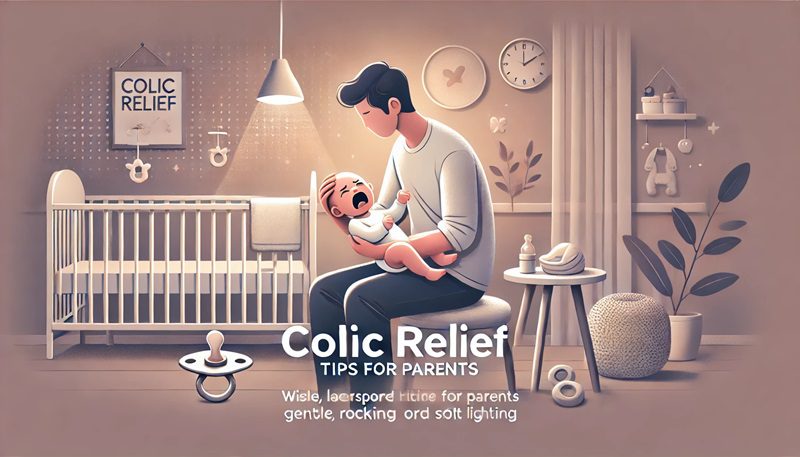As a parent, dealing with a colicky baby can be challenging and emotionally draining. The continuous crying, discomfort, and inability to soothe your little one can make you feel helpless. But don’t worry—there are several effective ways to help your baby through these tough times. In this guide, we will explore some of the best tips and techniques for managing colic and share some amazing products that can offer relief for both you and your baby. By the end of this article, you’ll feel more confident in handling colic in babies and know how to treat and cope with the situation.
One of the most challenging aspects of colic is understanding what triggers it and how to manage it effectively. For a more in-depth guide on colic symptoms and relief strategies for newborns, parents can explore this comprehensive resource. By equipping yourself with trusted information, you can make informed decisions about the best ways to soothe your baby.
What is Colic and Why Does it Happen?

Colic is defined by long periods of intense crying in an otherwise healthy baby. Typically, colic starts when the baby is around two to three weeks old and peaks around six weeks. While the exact cause of colic is unknown, there are several theories. Some believe it’s related to digestive issues, while others think overstimulation could be the cause. Regardless of the reason, the primary concern is how to soothe your baby during a colic episode.
For parents dealing with this, having the right tools can make a world of difference. One highly recommended product is the Baby Bottle, designed to reduce the amount of air your baby swallows during feeding, which is often a major trigger for colic.
Recognizing the Signs of Colic

Colic usually presents as excessive crying, often late in the afternoon or evening, lasting for hours at a time. These crying episodes may include clenched fists, a bloated belly, and the baby pulling their legs towards their abdomen. Recognizing the signs early can help you prepare and use various methods to calm your baby.
One of the most challenging aspects of caring for a baby with colic is the overwhelming exhaustion that comes with sleepless nights. Parents dealing with colic often experience sleep deprivation, which can affect their physical and emotional well-being. If you’re breastfeeding and struggling to get enough rest, check out our How to Deal With Sleep Deprivation After Baby for practical tips and advice on how to manage your energy levels while providing the best care for your little one.
Colic in Babies – How to Treat and Cope

Understanding colic in babies is essential to effectively treat and cope with the situation. A few simple techniques can help relieve the symptoms:
- Adjust the Feeding Position: Feeding your baby in an upright position can minimize the amount of air swallowed during feeding. Using products like the Colic-Reducing Nursing Pillow from our store ensures your baby is positioned comfortably and at the correct angle during feeds.
- Burping Often: Ensure that you burp your baby frequently during and after feeds. Trapped gas can exacerbate colic, so regular burping helps relieve this discomfort.
- Swaddling: Wrapping your baby in a swaddle can provide a sense of comfort and security, mimicking the womb. Many parents find that swaddling helps calm colicky babies and reduces their crying spells.
10 Tips to Soothe Your Crying or Colicky Baby

- Gentle Motions: Babies find rocking, bouncing, or riding in a stroller comforting. Try using gentle motions, such as swinging them in a cradle or rocking chair, to help ease their discomfort.
- White Noise or Soft Music: Babies are often comforted by the hum of white noise or soft lullabies. Using a white noise machine or playing calming music can soothe your baby during colic episodes. Check out our Portable White Noise Machine, which is perfect for providing consistent sound relief, both at home and on the go.
- Warm Baths: A warm bath can help relax your baby and provide relief from colic symptoms. The soothing sensation of water can distract your baby and ease tummy discomfort. After the bath, be sure to give your baby a gentle massage, which may further reduce colic pain.
- Tummy Time: Letting your baby have supervised tummy time can help release gas and relieve pressure. Gently massaging your baby’s belly in a clockwise motion may also help ease their discomfort.
- Change in Diet (For Breastfeeding Mothers): If you’re breastfeeding, certain foods in your diet could be contributing to your baby’s colic. Dairy, caffeine, and spicy foods are common culprits. Try eliminating certain foods from your diet to see if there’s any improvement.
- Switching to a Different Formula: If your baby is formula-fed, you might want to try switching to a formula specifically designed for sensitive tummies. These formulas are easier to digest and can reduce colic symptoms.
- Pacifiers: Some babies find comfort in sucking. Using a pacifier can provide immediate relief for a colicky baby by distracting them from their discomfort.
- Car Rides: Sometimes, the gentle motion of a car ride is enough to calm a fussy baby. If you’ve tried everything else and nothing seems to work, a short drive might help.
- Wear Your Baby: Using a baby carrier to wear your baby close to your chest can be incredibly soothing for them. The warmth of your body and the motion as you walk around will help ease their colic symptoms.
- Maintain a Calming Environment: Overstimulation can often make colic worse. Keeping the lights dim and noise levels low can help soothe a colicky baby. Try limiting your baby’s exposure to loud TV, bright lights, or other overstimulating elements.
Diaper blowouts and leaks can be one of the more stressful aspects of parenting, especially when you’re already dealing with a fussy, colicky baby. Choosing the right diaper size and fit is crucial to minimizing leaks. Additionally, investing in diaper covers or extra-absorbent diapers can provide an extra layer of protection during nap time or overnight. If you find that leaks are becoming more frequent, it might be worth considering Managing Diaper Blowouts and Leaks that offer better coverage and fit. A [product link: diaper rash cream] is also essential to keep your baby’s skin protected and irritation-free after accidents. Be sure to check out these essentials to keep both you and your baby comfortable during those challenging moments.
Soothing a Colicky Baby

One of the most important aspects of managing colic is finding what works for your baby. Every baby is different, and what works for one might not work for another. Consistency is key, so if you find that rocking, white noise, or tummy time helps, try to incorporate these methods regularly into your routine. If you’re unsure where to start, trying multiple techniques in small doses can help you find the best way to soothe your baby.
Remember, soothing a colicky baby is as much about finding what works for your baby as it is about being patient and persistent. The 10 Tips to Soothe Your Crying or Colicky Baby we’ve outlined above will provide you with plenty of options to try. Products like the Portable White Noise Machine, the Anti-Colic Baby Bottle, and the Colic-Reducing Nursing Pillow from our store can also make a significant difference in managing your baby’s colic.
When to Consult a Doctor

While colic is generally harmless and tends to resolve itself by the time your baby is 3 to 4 months old, it’s essential to consult a doctor if:
- Your baby’s crying is accompanied by a fever, vomiting, or diarrhea.
- You notice blood in your baby’s stool.
- You’re concerned that something else may be causing your baby’s distress.
A pediatrician can offer more personalized advice or suggest treatments to help soothe your baby if colic becomes overwhelming.
While dealing with colic can be challenging, it’s important to stay informed about other common newborn health conditions, like jaundice. Jaundice in newborns is a common condition caused by elevated levels of bilirubin in the blood. It typically presents as a yellowing of the skin and eyes. Understanding the symptoms, causes, and available treatments for jaundice can help you better care for your baby during these early weeks. Learn more about Jaundice in Newborns – Symptoms, Causes, and Treatment to ensure your little one’s health and comfort.
Final Thoughts on Colic in Babies – How to Treat and Cope

Colic can be tough, but by using the right methods and products, you can make the experience more manageable. Remember to stay calm, be patient, and try out different techniques until you find what works best for your baby. Colic doesn’t last forever, and with the help of products like the Anti-Colic Baby Bottle and Portable White Noise Machine, you can minimize both your baby’s discomfort and your stress.
By following these tips and incorporating the right tools into your routine, soothing a colicky baby becomes a much more manageable task. Remember, you’re not alone in this, and many parents have successfully navigated colic with the right approach and a little patience.
Traveling with a baby can feel overwhelming, but with the right gear, it becomes much more manageable. Essentials like a lightweight, compact stroller and a travel-friendly car seat can make navigating airports and road trips easier. Don’t forget to pack a baby carrier for hands-free convenience, especially when you’re on the go. Whether you’re planning a quick weekend getaway or a long-haul flight, having the right baby gear can keep both you and your little one comfortable and stress-free. Learn more about How to travel with a baby, and the gear you need and explore the must-have items that will make your journey smooth.

